A Visit to Rohatyn in 2008
last revised: 13 March 2011
 In February 2008, my husband and I made a trip
to Rohatyn, the birthplace of my paternal grandmother.
The trip was a culmination of a decade's effort, on and off, to learn what happened to those she left behind when she emigrated to NYC with her parents and sisters in 1914, and to get a picture of what life had been like in Rohatyn before the War.
In February 2008, my husband and I made a trip
to Rohatyn, the birthplace of my paternal grandmother.
The trip was a culmination of a decade's effort, on and off, to learn what happened to those she left behind when she emigrated to NYC with her parents and sisters in 1914, and to get a picture of what life had been like in Rohatyn before the War.
While the trip itself was inspired by these personal and family reasons, the main purpose of the following is to assist others who may also go to Rohatyn in the future as we did - without a guide, without speaking the language, and without meeting with local town officials - to more easily find some of the town's current and forgotten sites, including the memorials erected in 1998 to those who were killed in the fields on the "outskirts" of town - something we were not able to find on our own while there.
We are going back to Rohatyn in Spring 2011.
The image below is a composed panorama of the town, taken from near
the old wooden Saint Nicholas church (on a hill east of the town square).
The view is westward, toward the town square. In addition to the Saint
Nicholas church seen in the foreground on the left, you can also see the
back of the Roman Catholic church and the steeple of the Ukrainian church
(both on the town square) in the left-center of the panorama, and another
silver-domed church in the right-center of the view.
Click on the image below to see a larger version of the panorama.

Around the Roxolana Square:
 The main town square or Rynek is today called Roxolana square, and features
many businesses as well as two of the main driving routes into and out of
the town center. In pictures further below on this page, we have recorded
each of the buildings which face the square, for correlation to information
on other websites. For an more thorough description of the town square's
Ukrainian history and the interesting history of Roxolana, see
Roman Zakharii's excellent Rohatyn information webpage.
The main town square or Rynek is today called Roxolana square, and features
many businesses as well as two of the main driving routes into and out of
the town center. In pictures further below on this page, we have recorded
each of the buildings which face the square, for correlation to information
on other websites. For an more thorough description of the town square's
Ukrainian history and the interesting history of Roxolana, see
Roman Zakharii's excellent Rohatyn information webpage.
The image below is a another composed panorama, this time of the town
square. The image starts at the northeast corner of the square, then
turns clockwise a complete 360-degree view around the square, ending
back at the northeast corner. Toward the left of the panorama, as the view sweeps southward along the east block of the square, you can see Shevchenko Street and then the large steeple of the Roman Catholic church. The view then sweeps along the south block of the square; I
am in the center of the image, with the square's southwest corner behind
me. Toward the right of the panorama, the view sweeps northward along
the west block of the square, and reaches the Ukrainian church, just
off the northwest corner of the square. Finally, the view sweeps
eastward along the north block of the square, ending at the northeast
corner (behind the tree at the far right of the panorama). You can
click on the image below to see and scroll on a larger version of the
panorama.

What follows is a set of photos of each building on the modern town
square, divided by blocks, and sweeping in the same order as the square
panorama above. This also duplicates the sequence posted by Phyllis Kramer
on the
JewishGen Shtetlinks webpage for the Rohatyn Rynek, from information
provided by Jack Glotzer, Herman Skolnick, Howard Steinmetz, and Alexander
Walzer, correcting for compass direction. That list of businesses, from
before WWII, lists a few businesses once owned by members of my family.
You can click on any of the pictures below to see a larger version.
East Block:
The east block of the town square is Halitska Street, the primary north-south
road through the center of town. In the images below, the first (peach-colored)
building is at the northeast corner of the square (actually just off the square,
at the corner of Ivan Franko Street); today it is a pharmacy. The images then
run in order as we sweep southward along the block. The large green building
is on Halitska Street at the corner of Shevchenko Street, which becomes the main
eastward road out of town, toward Pukiv, Berezhany, and Ternopil. Across
Shevchenko Street (continuing south along the block) is the large Roman
Catholic church, and finally a single building which begins a new block
on Halitska Street heading south away from the square.







South Block:
The south block of the square begins at the southeast corner (across Halitska
Street from the last building above). Today this is the start of the square;
in the first image below, the building with the domed turret on the corner is
at #1 Roxolana Square, and the building numbers increase as you travel westward
along this block. The block ends with the large white building at the southwest
corner.




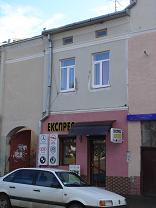




West Block:
The west block begins at the southwest corner of the square, with the green-trimmed
Nadra bank building; the tannish building at the left of the first image below is a
multi-purpose building (market, professional offices, etc.) on a street off the square
to the south. Moving northward along the block, there are a number of buildings of
various shapes and sizes, ending with the wide cooperative building on the corner
of Kotsjubinskogo Street. Across that street is the Ukrainian church (just off the
square at the northwest corner).

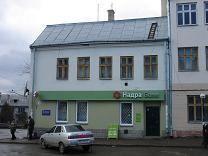










North Block:
Referencing again the Ukrainian church just off the northwest corner of the square,
the north block of the square begins with the green "Technica" building. Moving
eastward along the block, we pass a small alley between the green- and pink-trimmed
buildings, and end at what today is a brick building under renovation, at the
northeast corner of the square.




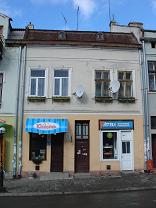







Family Building Sites On and Off the Square:
My grandmother, Annie (Chaike) Horn, was born in Rohatyn on Purim night 1911 to Isak and Rose Horn, merchants. According to my grandmother, the Horn family had lived in Rohatyn for generations: she was born in the same house in which her father had been born and his father's father had been born. The Horns owned and ran several business on the Rynek, including a saloon/restaurant (Yonah Horn), bakeries (David, also known as Dudka, Horn), and another saloon (owned by the Fruchter family, married to Horn daughter Matyl). The Liebling family (married to Horn daughter Tonka) owned a lumber yard in town.
There were 9 Horn children born to Yosef Horn (also known as Yehoshua) and Rebeka Kurzrock. Annie's father Isak, my great-grandfather, was the oldest, and David Horn, the youngest. In between there were Jute (Julia), Bronia, Yonah (also known as Jojny), Matyl, and Tonka, plus two other children, their identities and gender unknown (although likely females).
The Horns were a family of merchants and entrepreneurs. David, the youngest, owned bakeries, one on the Rynek and one just outside of Rohatyn in Podgrodzie. David financed a Vienna education for his two older sisters, Julia and Bronia: the former studied dentistry and medicine; the latter, philosophy and German and French literature.
David traveled throughout Galicia on business, and was a successful entrepreneur. From Vienna he bought a state-of-the-art roll-making machine for his Rohatyn bakery that could make 1000 rolls per hour!
In Rohatyn in 1936, David's older sister Bronia married Jacob Hornstein; he put her on his passport; Bronia was at least 10 years older than Jacob; by marrying, they were able to flee to Palestine, divorcing in 1937. Bronia's older sister Julia joined them in Palestine in 1934, preceded the year earlier by her husband Joachim (Chaim) Teichman, a lawyer from Chodorow. Of the nine Horn children, only Isak, Julia, and Bronia would survive the War.
Jacob Hornstein had a sister, also named Bronia. She was married to David Horn and they had 3 daughters, Regina, Dvora, and Malka. Jacob could not convince them to leave Rohatyn for Palestine. David was shot and killed not long after the Rohatyn ghetto was established in the summer of 1941 when he had attempted to defend his nephew against attacks by a German Officer. After David's death, his wife Bronia fled to the neighboring woods with the girls, but returned to Rohatyn with only two of the daughters, thereafter hiding in the basement of the former Horn residence, now occupied by a non-Jewish family. (Theirs had been one of the few houses in town that had indoor plumbing, and which subsequently served as a hiding place for other Rohatyn Jews during the War). While in hiding, a Ukrainian woman who had been a nanny to the family, kept Bronia and her two girls alive by smuggling food to them. At some point, however, Bronia and the girls were discovered and denounced and marched to their deaths before a handful of onlookers. According to Yad Vashem, their deaths occurred between 1942 -1944. We can speculate that their bodies silently lie in one of Rohatyn's two mass graves. As for the fate and identity of the third daughter, nothing is known: not who she was nor when, where, and how she died. What is known is that she did not survive.
Yonah Horn owned a restaurant/tavern in town with his father Yosef. The 1923 Rohatyn Business Directory had telephone numbers 11 and 41 assigned to them! Yonah's tavern was a popular lunch spot for Rohatyners, and young men commonly pursued friendly games of poker in the back room. When the ghetto was established in July 1941, Yonah was a member of Rohatyn's Judenrat. He and his fellow "members" were killed on June 6, 1943 according to the Rohatyn Yizkor Book and their bodies publicly displayed.
One of the spare rooms in a Horn house, possibly the house of Matyl Horn Fruchter, was used for meetings of Rohatyn's HaShomer Hatzair youth group. Matyl's son, Munio belonged to HaShomer Hatzair. He was dark and attractive and had a beautiful singing voice. All of the Fruchter family was killed between 1942-44 according to Yad Vashem.
Tonka Horn Liebling and her husband owned a lumber yard in Rohatyn located near the entrance to the Jewish ghetto. Tonka was known for having a lovely home near the Rynek that was always busy with visitors. She was said to carry herself like a real lady. No one from the Liebling family survived the War.
There were 3 official and documented "Aktions" (liquidations of the Jewish population by the Nazis) in Rohatyn: March 20, 1942; December 8, 1942; and June 6-8, 1943. When the Soviets re-entered Rohatyn after the War and officially tabulated (from testimony) the loss of life and property, the larger, destroyed Horn family totaled more than 75. This figure included the various Horn, Fruchter, and Liebling families.
There are two documented mass grave sites in Rohatyn. Records show that two transports ran from Rohatyn to the nearby Belzec concentration camp, in September and December 1942.
For the most part, however, the Jews of Rohatyn were exterminated in their own city, their bodies - in excess of 3,500 - dumped into one of two mass graves.
The pictures below are of buildings we believe were owned by the family, on and off the Rynek. To help identify them, we used detailed letters from the late Herman Skolnick, whose family knew the Horns, as well as notes taken from telephone conversations nearly a decade ago with Herman Skolnick and the late Jacob Hornstein, whose sister Bronia was married to David Horn, discussed above. This information was then coordinated, to the best of our abilities, with the List of Businesses around the Market Place Before WWII, from the
Rohatyn JewishGen Shtetlink website managed by Phyllis Kramer.
 |
This corner building, on the east block of the square across from what is today the
Roman Catholic Church, was likely the saloon/restaurant of Yonah Horn.
According to Herman Skolnick and Rosette Faust Halpern, there originally had been 3 or 4 store
fronts at the street level. The parents of Willy Halpern (Rosette's future husband and in-laws) lived on the third floor, Dr. Stein on the second
floor, where he had both residence and medical office, and Mrs. Pocicha, a Polish woman, on the ground floor, where she had a meat and sausage shop. |
 |
This smallish building, second from the north end of the west block
of the square, was likely the Fruchter family's saloon/restaurant
(married to Horn daughter Matyl). |
 |
This building was heavily modified since
the War. However, its location at the north end of the west block -
across from what today is the Ukrainian Church and adjacent
to the road that led to the Rohatyn ghetto - was where David and Bronia Horn had
one of their bakeries. |
 |
Road to the left of what is today the Ukrainian Church that
led to the Jewish ghetto. Here, the family Liebling (married to
Horn daughter Tonka) owned and operated a lumber yard, per
Herman Skolnick. |
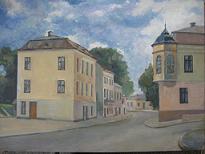 |
During the war, Bronia Horn and her daughters hid in the basement of this building, before being discovered and killed; this same basement also served as a hiding place for other Rohatyn Jews during the Nazi occupation. (Painting commissioned by Rohatyn resident Anna in 1998 for Jacob Hornstein)
Courtesy of the Hornstein Photo Archive with the permission of Harriet Hornstein Korim Arnoldi. |
Street Maps and Sites:

A current street map of Rohatyn is available on the town website at http://rogatyn.info
(in Cyrillic). The website is interactive, and allows you to find streets
by current name. The map to the left shows a number of monuments and significant
town features as well as four sites important to Rohatyn
Jewish history, including the two mass grave sites which we were unable to locate during our 2008 visit (click on the image for a larger version).
 See also the 1943 map found and annotated by Donia Gold Schwarzstein, at
See also the 1943 map found and annotated by Donia Gold Schwarzstein, at
http://www.shtetlinks.jewishgen.org/rohatyn/Rohatynmap.htm.
Photos of Old Rohatyn:
A number of old photos of Rohatyn from around the end of the first world war
are available at www.bagnowka.com, a Polish
organizer of custom tours in Poland and Ukraine. The photos are copyright Tomek
Wisniewski and bagnowka.com; you can see them on the original website by clicking
on the thumbnails below.
 |
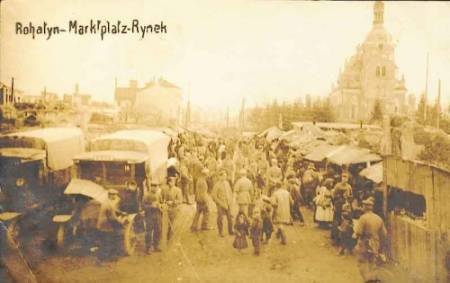 |
 |
 |
 |
| A view of town from near the St. Nicholas church, looking northwest toward
the rynek (market square). The Roman catholic church is visible in the center of
the image; the Ukrainian church is visible to the left. |
The market square, looking east toward the Roman Catholic church. |
Another view of the market square, looking southwest. |
The Jewish cemetery. |
One of the two remaining Jewish cemeteries, today. |
A Few Horn Family Photos & Documents:
Click on the images below for larger versions.
 |
Bronia and Malka (Milunia) Horn - Rohatyn 1937
Courtesy of the Hornstein Photo Archive with the permission of Harriet Hornstein Korim Arnoldi. |
 |
Malka and Regina Horn - Rohatyn 1937
Courtesy of the Hornstein Photo Archive with the permission of Harriet Hornstein Korim Arnoldi. |
 |
Bronia, David, Regina, Devora, and nanny Dora - on vacation in spa town Iwoczynia, 1928
Courtesy of the Hornstein Photo Archive with the permission of Harriet Hornstein Korim Arnoldi. |
 |
Regina and Devora Horn - Rohatyn circa 1932, possibly in front of one of the Horn businesses.
Courtesy of the Hornstein Photo Archive with the permission of Harriet Hornstein Korim Arnoldi. |
 |
Bronia Hornstein Horn and David Horn, possible wedding photo.
Courtesy of the Hornstein Photo Archive with the permission of Harriet Hornstein Korim Arnoldi. |
 |
Rohatyn Hebrew School photo circa 1937 showing Regina, Dvora, and Malka, 3 daughters of David and Bronia Horn, as well as daughter of Yonah Horn, David's older brother.
Courtesy of Rosette Faust Halpern. |
 |
David & Bronia Horn residence on Pilsduskiego Street, photographed in 1998. On the second floor resided the jurist, Dr. Kleinberg, who maintained his legal office on the first floor, per Herman Skolnick. Across the street at 8 Pilsduskiego lived Chaim Skolnick, father of Herman Skolnick.
Courtesy of Bea Glotzer. |
 |
Michael Bilan, manager of the Rohatyn electrical plant who rented an upstairs room or apartment in David & Bronia Horn's house, and one of the "Righteous Among Nations" for having helped Rohatyn Jews during the War, per Rosette Faust Halpern and Herman Skolnick. Family lore said that the Horn family was in partnership with Michael Bilan, but this is still unconfirmed. |
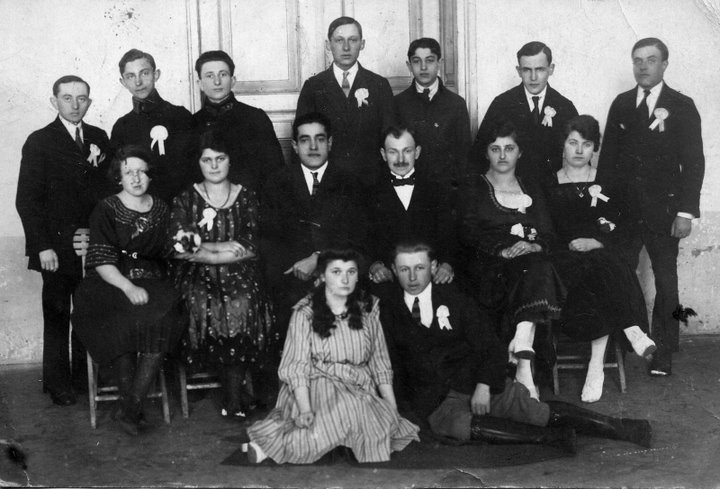 |
Photo with Tonka Horn (middle row, second from the left), photo from Alex Feller.
Reproduced on page 159 of the Rohatyn Yizkor Book (Hebrew version).
The caption (from the Yizkor English translation) reads: The production of
King Lear, December, 1920 - Chaim Drooks, Avraham Tupp, David Prageh, Fishel
Weiler, Unknown, Guttwort, Yaakov Foist, Shaul Pancher, Hinde Baum, Tova Baraban,
Dr. Leibush Zlaks, Yitzchak Bernstein, Tunke Horen, Reize Leiter, David Rosenstein,
Devorah Hoizer. |
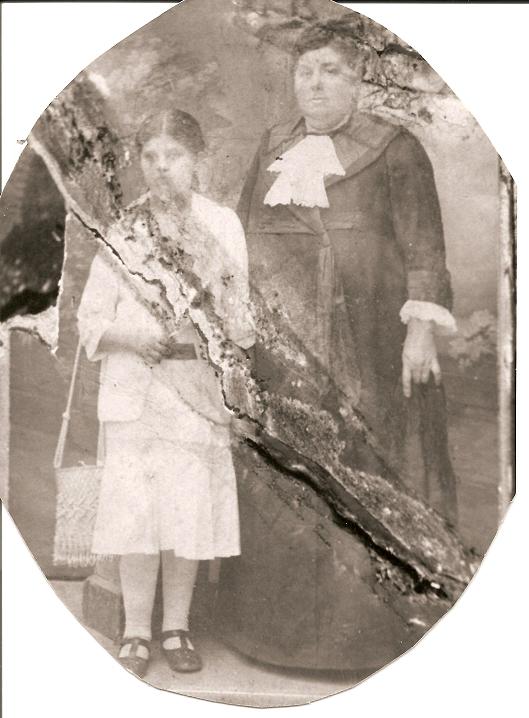 |
My great-great grandmother Rebeka Horn with one of her daughters, probably Tonka Horn, later Tonka Liebling.
|
 |
1936 Passport photo of Bronia Hornstein (nee Horn), briefly married for purposes of emigration to Palestine to Jacob Hornstein.
Courtesy of the Hornstein Photo Archive with the permission of Harriet Hornstein Korim Arnoldi.
|
 |
1933 Aliyah Polish Passport for husband of Julia, Joachim (Chaim) Teichman |
 |
1937 Aliyah Polish Passport for Joachim Teichman |
 |
1934 Aliyah Passport for Dr. Jute (Julia) Teichman nee Horn |
 |
Winter 1947 photo of Julia Horn Teichman in Palestine |
 |
Children of Yonah Horn - Rohatyn school photos circa 1937.
Courtesy of Rosette Faust Halpern. |
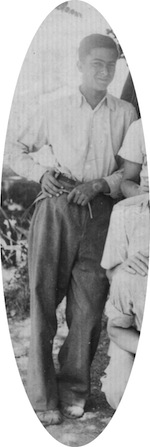 |
Munio Fruchter, son of Matyl Horn Fruchter - Rohatyn circa 1935.
Courtesy of Rosette Faust Halpern. |
Suggested Reading:
In addition to the wealth of information on the JewishGen websites and
other links below, I have found these two books to be meaningful to my own
research:
Acknowledgements & Links:
Many thanks to Phyllis Kramer, Cipora Blitz, Donia Gold
Schwarzstein, and Linda Cantor for their numerous
emails that helped to make our visit (and this
material) possible. A special thanks to Roman
Zakharii for his patience in kindly answering all our
emails, and most especially, for the detailed
information, maps, and photos he made available to
us through his website and his own sources.
To see more photos from our 2008 trip to Rohatyn, visit our website.
A fond and deep thank you to two special Rohatyners
who are no longer with us, Herman Skolnick and Jacob
Hornstein. Their numerous letters and phone calls
in the late 1990s fueled my passion about the town
and provided invaluable details about my grandmother's
"lost" Rohatyn family.
Of course, my lifelong desire to visit Rohatyn grew out of the many stories and comments I heard as a child and young adult from my grandmother Annie (Chaje) Horn and her youngest sister (my great-aunt) Rebecca (Becky), who passed away in 2003 and 2010 at age 92 and 89, respectively. They were the last of that original Rohatyn generation for my family. Both Annie and Becky were daughters of my great-grandfather Isak, the oldest of the Horn siblings of Rohatyn. In addition, I have been fortunate to have been recently befriended by Harriet Hornstein Korim Arnoldi, daughter of Jacob Hornstein, who visited Paris and presented me with one of the most beautiful gifts I have ever received - the above photos of David, Bronia, Regina, Dvora, and Malka Horn, as well as the painting of their home in Rohatyn, commissioned by Harriet's father Jacob following the 1998 Rohatyn "reunion" of survivors where memorials were dedicated to those killed during the War. And finally, I am forever grateful to have been able to share many hours with Shoah survivor Rosette Faust Halpern - friend, teacher, fellow francophile - who went to school with several of the Horn children and was one of a small handful who staggered out of the Rohatyn ghetto when the Germans were defeated. She has been an amazing source of information, stories, and details about my family and Rohatyn before and during the War.
Lovingly dedicated to my grandmother Annie Horn, and to her sister Becky.
Kind regards,
Marla Raucher Osborn
osborn "at" nuthatch.org
 In February 2008, my husband and I made a trip
to Rohatyn, the birthplace of my paternal grandmother.
The trip was a culmination of a decade's effort, on and off, to learn what happened to those she left behind when she emigrated to NYC with her parents and sisters in 1914, and to get a picture of what life had been like in Rohatyn before the War.
In February 2008, my husband and I made a trip
to Rohatyn, the birthplace of my paternal grandmother.
The trip was a culmination of a decade's effort, on and off, to learn what happened to those she left behind when she emigrated to NYC with her parents and sisters in 1914, and to get a picture of what life had been like in Rohatyn before the War.



































































